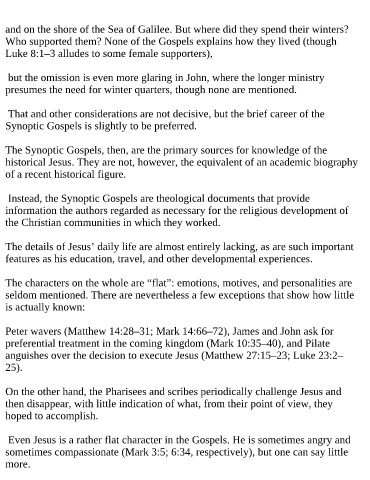Page 400 - ILIAS ATHANASIADIS AKA RO1
P. 400
and on the shore of the Sea of Galilee. But where did they spend their winters?
Who supported them? None of the Gospels explains how they lived (though
Luke 8:1–3 alludes to some female supporters),
but the omission is even more glaring in John, where the longer ministry
presumes the need for winter quarters, though none are mentioned.
That and other considerations are not decisive, but the brief career of the
Synoptic Gospels is slightly to be preferred.
The Synoptic Gospels, then, are the primary sources for knowledge of the
historical Jesus. They are not, however, the equivalent of an academic biography
of a recent historical figure.
Instead, the Synoptic Gospels are theological documents that provide
information the authors regarded as necessary for the religious development of
the Christian communities in which they worked.
The details of Jesus’ daily life are almost entirely lacking, as are such important
features as his education, travel, and other developmental experiences.
The characters on the whole are “flat”: emotions, motives, and personalities are
seldom mentioned. There are nevertheless a few exceptions that show how little
is actually known:
Peter wavers (Matthew 14:28–31; Mark 14:66–72), James and John ask for
preferential treatment in the coming kingdom (Mark 10:35–40), and Pilate
anguishes over the decision to execute Jesus (Matthew 27:15–23; Luke 23:2–
25).
On the other hand, the Pharisees and scribes periodically challenge Jesus and
then disappear, with little indication of what, from their point of view, they
hoped to accomplish.
Even Jesus is a rather flat character in the Gospels. He is sometimes angry and
sometimes compassionate (Mark 3:5; 6:34, respectively), but one can say little
more.

